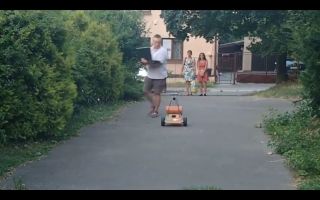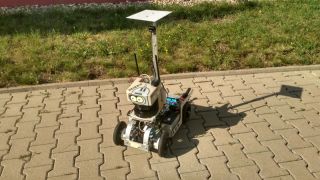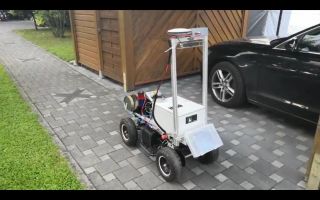Introduction of teams
jackal and the veterans
There are 13 registered teams (3 of them have incomplete registration at the moment) for Robotour 2018 which will take place in Czech Republic (castle garden Lednice) on 15th of September 2018. The teams are mostly veterans except The JK-Team from Technical University Deggendorf, which will come with their commercial platform Jackal from Clearpath Robotics. We can again look forward to see participants from Czech Republic, Germany, Slovakia and Switzerland.
Teams
YouTube playlist of all registrations 2018
ARBot (CZ)
youtube https://youtu.be/tupkkdEAalI
Robot is controlled by SBC UP2. It has 8G RAM, 128 GB SSD, WiFi and BT. The
heart is four-core Intel N4200. UP2 runs on Windows 10 and .NET and C# language
is used as the main programming platform.
The robot will be driven by completely new code, if it will move, with new algorighms for this year.
The chassis is differentially driven with 3rd passive wheel. The modeller
wheels have diameter 17 cm and two motors PG36555126000-50.9K with encoders are
controlled by professional unit SDC2160 by Roboteq provide necessary
traction. There are two optical odometers ADNS 3080 for further position
improvements. Another sense input is lidar A2 from Smateck.
Time-tested AHRS VN-100 from VectorNav provides information about robot
orientation. The global position information is handled by GPS uBlox NEO 7M.
Robot will navigate with stereo camera R2000 with stabilized gimbals
based on BGC Storm32 this year.
The energy source are 4 LiFePo cells with capacity 14.5 Ah and protected by
SBM. The chassis is built from 2mm thick plywood for air models and 7 mm spruce
beams. Simply model domain. All parts were cut by laser.
BII (CZ) [incomplete registration]
BII is medium size wheeled robot with 2WS rear wheel drive. The main computer
runs on Xubuntu. The communication with the computer, where we do all the
changes of SW and check run of the program, is realized via router.
Robot software is based on ROS — it reads data from sensors and sends
commands to mbed, which controls the robot motion. "Robot's Eye" is at current
stage laser scanner sick, encoders and IMU. Robot is nevertheless able to use
also GPS and camera, but they are not used for navigation at the moment.
Cogito (CH)
Winner of Robotour 2017. If it works, do not fix it. So for this year,
we focus on small improvements and on fixing parts that did not work
ideally. Our robot Clementine is still powered by two stepper motors
with encoders, it still senses the world by a stereo camera, one and a
half lidars, compass and GPS. Software runs on a slightly faster Intel
NUC than last year and it should be more polished and well-tuned than
radically different from 2017 version.
Istrobotics (SK)
youtube https://youtu.be/wxFW0YvzRpo
The robot is modified RC model TRAXXAS E-MAXX (3903) equipped with webcamera,
GPS, RPLIDAR, sonars HC-SR04, IMU with 3D compass and magnetic IRC. The robot
control and basic sensor processing is done on Arduino mega. Image processing,
lidar and navigation is computed on Raspberry Pi 3. Robot is programmed in C++
and OpenCV.
JECC Fesl (DE)
youtube https://youtu.be/oKC3MlO6y3E
Neural Network based vision processing. GPU & Intel Xeon Powered
industrial PC.
JECC Lois (DE)
youtube https://youtu.be/DAgiG2MgRWE
Robot Lois with neural network running on Nvidia Jetson.
(The) JK-Team (DE)
youtube https://youtu.be/-enBUI6v8ZM
Commercial platform "Jackal" based on Linux and ROS.
(Technische Hochschule Deggendorf)
MART (CZ) [incomplete registration]
The robot chassis is composed of two independent halves connected by an axis.
This solution helps to better handle terrain conditions. The wheels are driven
via belts connected to two industrial stepper motors (one on each side,
i.e. robot is differentially driven). Motors are driven by control unit
attached to CAN network. The power source are two Pb batteries taken from UPS.
Robot is controlled by BeagleBone Black pair. It uses inertial unit, compass
and GPS. RangeFinder SICK LMS-100 and sonars are used for obstacle detection
and better localization. There is an extra carriage built for transport of beer.
MRVK (SK)
Differentially driven 4-wheel robot. The power is provided by 22 NiMH batteries
with capacity 16000mAh. The robot is controlled by PC with processor Intel i7.
Sensor set contains geodetic GNSS system, laser scanner Hokuyo, HDR
camera See3CAM_CU20, compass, 6 DOF IMU. The software runs on ROS Kinetic with
Ubuntu operating system.
ND Team (CZ)
youtube: https://youtu.be/LvW8OJGGO38
Robot Robík
Robot dimensions:
- length 84 cm
- width 48 cm
- height 60 cm
- clearance of the base above the terrain 12 cm
- weight 23 kg
Used materials:
- welded frame from aluminium square tubes
Powertrain:
- differentially driven
- pairs of wheels connected with belts
- two motors GMP 56-60107
Power:
- 8x 5 Ah battery LiPol (29.6 V) in airplane-modeller (soft) setup
- light, high discharge current in case of need, reasonable drive time
Power for control electronics:
- 3S2P 5 Ah LiPol in airplane modeller (soft) setup (11,1V / 10Ah)
- separate from motors power
Sensors:
- Webcam
- Lidar scanner own design
- GPS, 9-axis IMU
Control:
- custom design board CortexPilot for real time operations (microcontroller Cortex M3)
- Odroid XU4 + 7" touch panel + video processing, path planning and obstacle avoidance
Robosoft (SK) [incomplete registration]
Robot Neuron
Control PC:
Intel Core i7, 8GB Ram, 64GB SSD, 8x USB, 6x RS232
with Matlab 2018a
Peripherals:
2xArduino Mega2560, 1xCMPS11, 1x Ublox NEO-7M,
4x Sonar for obstacle detection, 1x Hokuyo UST-10LX
1x Webcam Microsoft, 2x Encoder 360/600P/R
2x Motor 24V 180W
Power:
2x 12V,20Ah, 2x 5V, 4000mA
Short Circuits Prague (CZ)
youtube https://youtu.be/p0vDQWCxLA8
Robot is based on monster truck model 1:5 platform. The main processing unit
NVidia Jetson TX2 with Ubuntu. Hardware is monitored by Arduino
Duemilanove board. The robot sensor set contains magnetic encoder, compass with
tilt compensation, rear sonars (not active for this contest), ** 2 lidars**, GPS and
camera. Software is written in Python. Program receives latest information
about HW status via USB and Ethernet, connected directly to the main computer,
and from Arduino, which takes care of low-level signal processing (encoders, servos, motors).
Arduino collects this information, and regularly
sends messages to main program. These messages are then transformed into HW
independent structures.
PID speed controller, localization from odometry and compass, local environment
detection (from lidar and camera) and also the main task
— navigation on input path, runs on the main computer. Robot uses structure
Occupancy Grid Map for fusion of inputs from various sensors and Vector Field
Histogram method for grid map navigation.
Smely Zajko (SK)
youtube https://youtu.be/KHYZg-bct9s
- Parallax Motor Mount and Wheel Kit with encoders
- 2xHB25 motor drivers
- 2xArduino Nano, low-level control board
- PC Lenovo ThinkPad T430
- Nvidia Jetson TX2 (optional)
- Hokuyo UST-10LX
- RPLidar A2 (optional)
- 5x SRF-08 (front ultrasonic sensors)
- 4x HC-SR04 (back ultrasonic sensors + barrel detect)
- GPS NaviLock NL-302U USB SiRF III
- Compass with tilt compensation (HMC6343)
- AVR ATmega8 (compass driver)
- Huawei Y7 with Android (for camera)
- Power: HAZE HZS 12V 9Ah
- handmade wood & aluminium base
- red power switch and power circuitry
If you would like to somehow support this contest or you have some
comments/question, please use our standard contact form.












